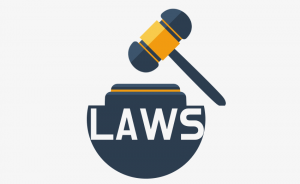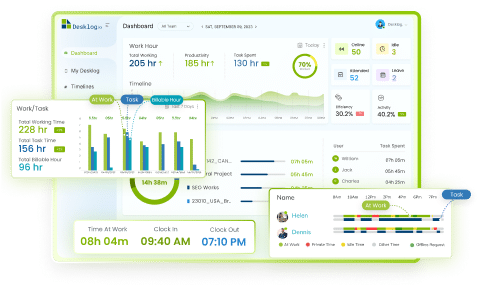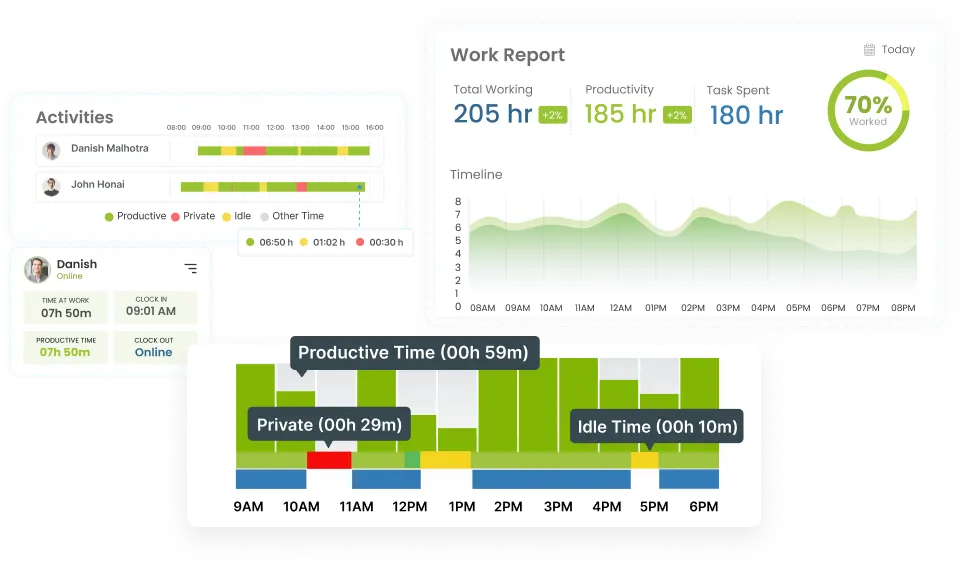
Employee Monitoring Policies to Avoid Breaking Employee Monitoring Laws 2024
Employee monitoring has been proven to be an effective tool for boosting productivity and increasing profitability in all types of organizations. But there have been questions raised about its ethical and legal aspects. Employee monitoring is not a new concept. It has been around for ages. Noting clock-ins and outs, attendance, camera surveillance, etc… can all be considered as employee monitoring. With time, the Employee Monitoring Software also changed. Employee web activities, emails, location data, phone calls, etc… are monitored today. It is common for employees to have privacy concerns about monitoring practices. But there are laws to protect the privacy of employees. Here we will have a look at employee monitoring policies to avoid breaking employee monitoring laws.
Employee monitoring laws
In most countries, it is legal for companies to monitor their employees. Most companies ask for permission from their employees, while some companies monitor their employees without even letting them know about it. There are no legal obligations in most countries for employers to disclose or notify their workers that they are being monitored. Employees are monitored in various forms based on their type of work. Any method of surveilling employees and their work can be acknowledged as employee monitoring.
It is legal for the employer to monitor computers owned by the company. According to the Electronic Communications Privacy Act, if a company gives computers to their employees for work purposes, it is still company property. The employer has all the right to observe what the employee is doing on it. This includes downloads, files, idle and active time, and internet use. It is also perfectly legal for companies to monitor their employees’ activities on the internet including the time online, websites visited, etc… It is also legal for employers to monitor the screens and keystrokes of employees. Mails from office computers and calls from office phones can also be monitored.
Know more aboutDesklog Employee Monitoring Policies
What to monitor
Employee monitoring should serve a purpose rather than being done just for the sake of it. Employers want to understand what their worker’s activities are during work hours and ensure that they don’t misuse their access to company data and systems. For that, it is normally sufficient to focus on the following categories.
Data
It’s necessary to know who accessed sensitive and confidential information and when to recognize a threat in the event of a data leak and ensure that no employee is overstepping their rank.
Keystrokes
Monitoring keystrokes enables you to check that workers use office computers for company purposes only and ensure they don’t share classified data with anyone.
Idle time
Keeping track of the time when an employee is not active on their computer gives employers further insights into their genuine productivity and efficiency.
External devices and drivers
Keeping track of the time when an employee is not active on their computer gives employers further insights into their genuine productivity and efficiency.
Visited URLs
The records of employees’ web activity show the complete list of websites and applications they visit and what they’re doing during work hours. Employers can also verify if employees access questionable resources.
Screen contents
By monitoring screenshots of employees’ computers, it’s possible to see everything on their screen. This type of monitoring can significantly increase employee efficiency. Also, the collected information can be valuable in the case of a cybersecurity incident.
Know more on 15 Most Asked Questions about Employee Monitoring Laws
Want to try our Time Tracking Software?
Try Desklog for free!

Tips to avoid breaking employee monitoring laws
1. Know what to monitor
Be mindful when deciding what types of digital employee activities to track and establishing rules for your workers. In some places, it is not legal to demand employees to verify their non-work online accounts or to require login information to their private accounts. Also, if your workers use personal devices for work, look for methods to monitor without interfering in their private matters. You will have to ensure that these devices aren’t tracked during non-working hours.
2. Determine who to keep an eye on
It is not necessary to monitor all employees similarly. Base-level workers with no access to confidential data can be monitored with less effort. All actions of high-level employees have to be strictly tracked and documented to assure the security of confidential information.
3. Set clear written policies
The most reliable way to assure productive workflow, legal compliance, and employee harmony is to establish clear policies and explain their significance to your workers. Ensure that the policies meet appropriate security standards like the Electronic Communication Policy, Bring Your Own Device Policy, and Confidentiality and Non-Disclosure Policy. All workers should get accustomed to the policies and give their signed consent to follow them.
4. Inform your workers about monitoring
Monitoring should be performed legally and ethically. Although the laws in most countries don’t demand you to inform your staff about digital monitoring, we suggest that you do. This will let them know for sure what’s monitored and what isn’t. You can also explain the motives behind such monitoring so employees know why they are being monitored.
5. Use employee monitoring software
Employee monitoring software can help conduct monitoring legally and effectively. You have to choose the software which will fit perfectly into your company’s workflow and fulfill all your needs. Select software that can monitor employees’ performance, guard your organization’s confidential assets, and help you keep up with industry regulations and legal parameters.
Desklog is an employee monitoring software with features such as App/URL tracking, Idle Time tracking. Offline Time Tracking, Automatic screenshots, Productivity Report, Document title tracking, Reports, Attendance Management, Absence Calendar, etc… It is suited for monitoring employees in all organizations and complies with all employee monitoring laws.
Conclusion
Digital employee monitoring is an essential component of contemporary workplace surveillance. Monitoring assists companies keep an eye on staff efficiency, protect confidential data, and prevent data leaks up to an extent. However, when monitoring employees, you must consider legal and ethical issues also.
Inappropriate monitoring can invade employee privacy and could cost the company lawsuits and severe fines. This is why organizations should comply with the legal aspects of workplace surveillance and consider them while monitoring their employees.
















